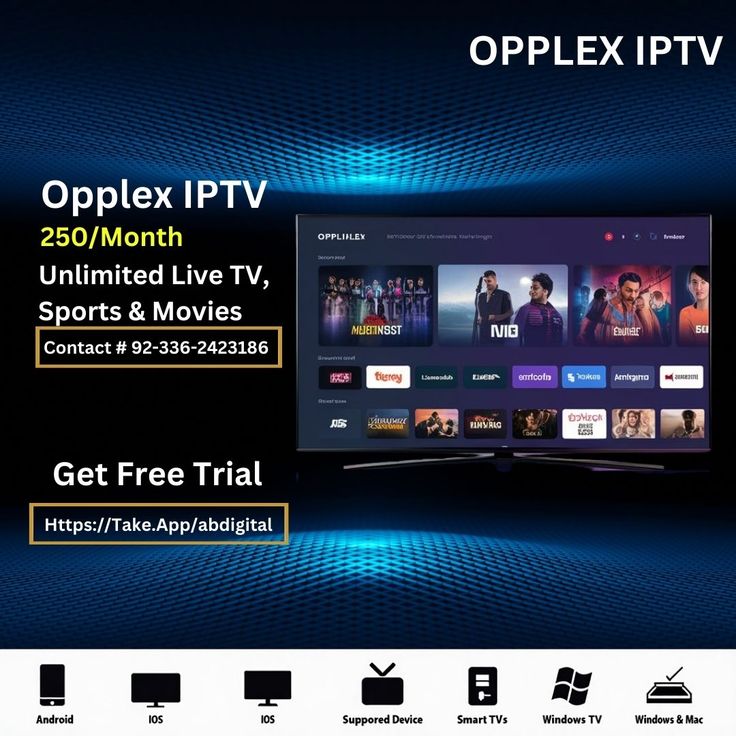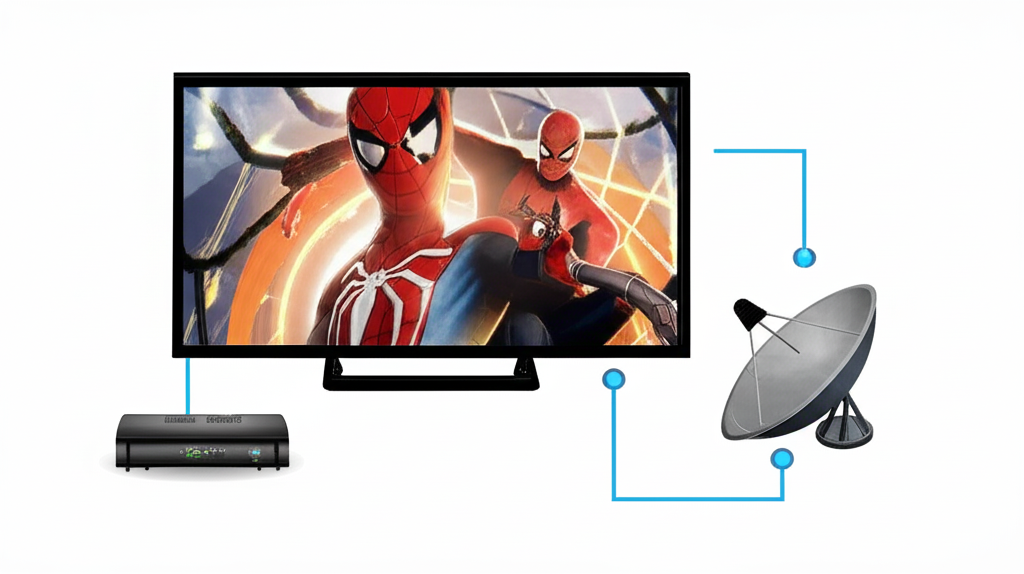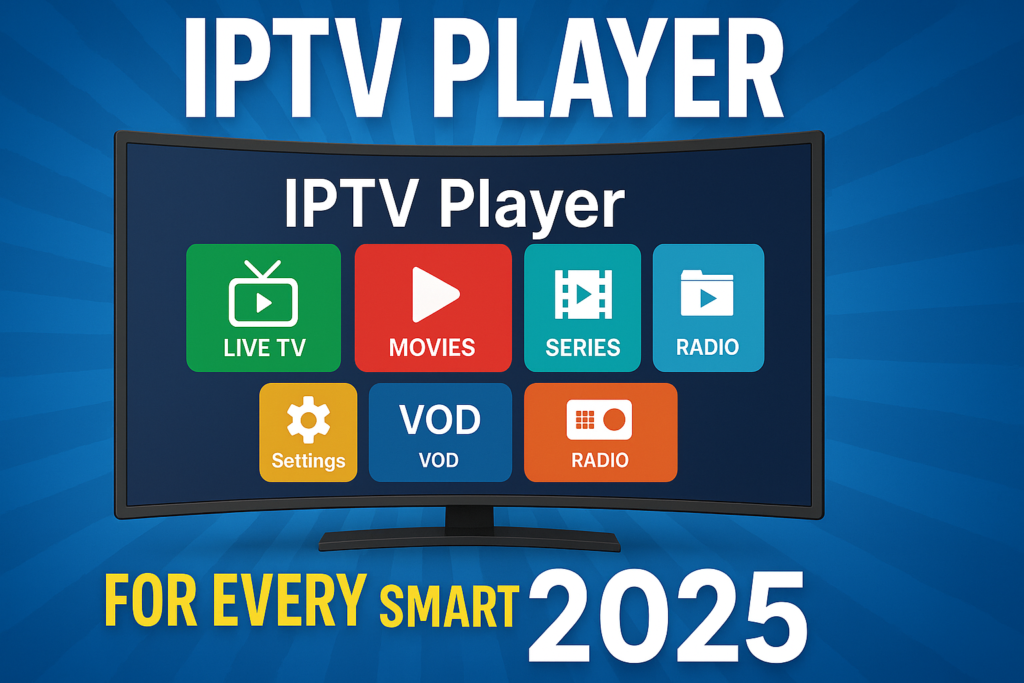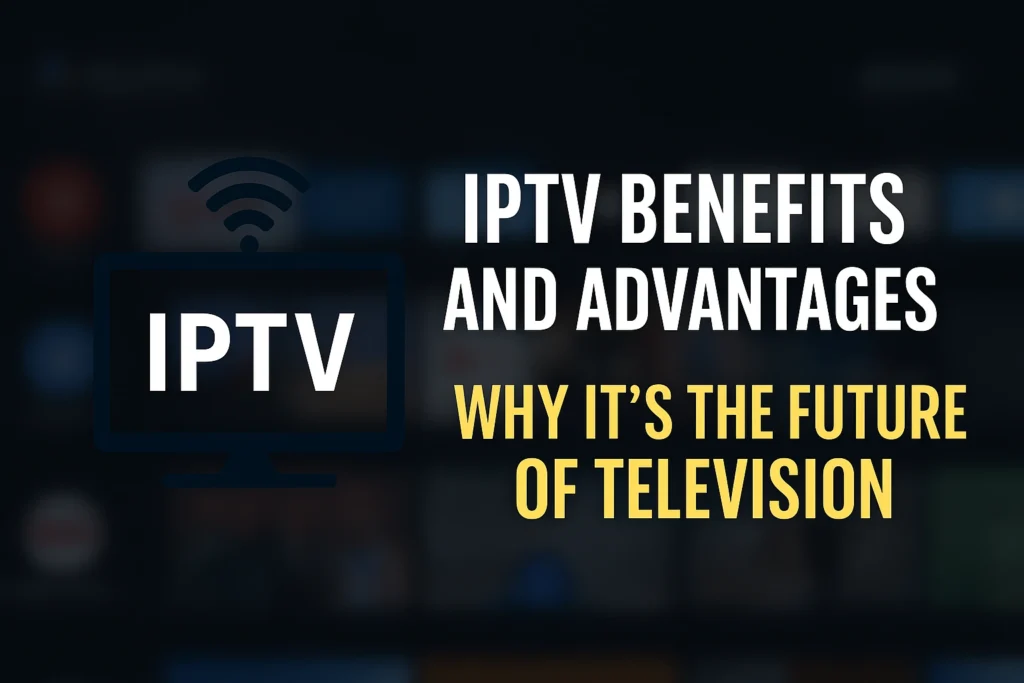What Exactly Is IPTV Subscriptions? Your Complete Guide to Internet Protocol Television and Its Top Advantages

Remember the days of flipping through a handful of channels, waiting for your favorite show to air, and enduring endless commercial breaks? For many of us, those days are quickly becoming a distant memory. Thanks to the internet’s pervasive reach and rapid advancements in technology, the way we consume television has undergone a massive transformation. Enter Internet Protocol Television (IPTV) – a game-changer that’s fundamentally reshaping our viewing habits by putting us in control.
IPTV isn’t just another buzzword; it’s a real-world solution to our desire for convenience and a more personalized entertainment experience. It offers a fresh take on accessing our beloved movies, shows, and live events, letting us watch them when we want, not when a broadcaster dictates.
So, what’s the big deal with IPTV? How does it actually work? And are there any hidden snags amidst all the hype? Let’s dive in and explore this exciting evolution in home entertainment digital success.
Unpacking the Basics: What is IPTV subscriptions?
At its heart, Internet Protocol Television (IPTV) is a method of delivering video content in real-time over the internet. Forget antennas, satellite dishes, or even traditional cable lines. With IPTV, your television content streams directly through your internet connection.
While it shares some DNA with popular online video platforms like YouTube or subscription-based services like Netflix (often called Over-the-Top or OTT services), IPTV distinguishes itself in how it delivers that content. Many IPTV services operate on a subscription model, granting you access to a vast library of Video-on-Demand (VOD) content, alongside the ability to tune into live broadcasts.
This shift has been fueled by a few key factors:
- The widespread availability and flexible nature of broadband internet.
- The ease of internet accessibility for everyday users.
- Increased competition among telecommunication and cable companies, pushing them to offer bundled data, voice, and video services.
Essentially, IPTV is paving the way for a next-generation TV experience, and it’s here to stay!
The Ascent of IPTV: A Look at Its Remarkable Growth
The IPTV industry isn’t just growing; it’s booming, with no signs of slowing down. The statistics paint a clear picture of its rapid expansion:
- Reports from “Markets and Markets” indicate a global annual growth rate of 30% to 35% for IPTV services, underscoring its escalating popularity.
- Globally, the number of IPTV subscribers has soared past the one-billion mark, a testament to its widespread acceptance.
- Europe, with France, Germany, and the UK at the forefront, boasts a significant share of the IPTV market.
- Interestingly, India is emerging as the fastest-growing IPTV market, poised to soon rival its European counterparts.
A significant driver behind this explosion is the sheer array of benefits IPTV offers. For advertisers, it presents a golden opportunity to connect with millions of viewers, making it a highly attractive platform for monetization, often through an advertising video-on-demand model.
Furthermore, the rise of internet-based streaming has encouraged IPTV solution providers to offer integrated services, combining traditional IPTV with OTT and general video/live streaming capabilities.
Real-World Applications: Where Does IPTV Shine?
Internet Protocol Television, or IPTV, is incredibly versatile. Its packet-based delivery system allows it to be seamlessly integrated with other IP-based services, such as Voice over IP (VoIP) and high-speed internet.
This technology supports a diverse range of services and applications, including:
- Video on Demand (VOD): Pick and choose what you want to watch from a library, anytime.
- Interactive TV: Engage with your content beyond simple viewing.
- Livestreaming: Catch events as they happen, in real-time.
- In-program messaging: Think interactive overlays or direct communication during a show.
- Time Shifting: This is where IPTV truly excels, allowing you to consume content outside of live broadcasts. This includes digital recording, accessing on-demand versions of previously aired shows, and even the ability to rewind or restart a live program that’s already in progress.
It’s worth noting that IPTV is a distinct player in the streaming landscape, often seen as a competitor to “Internet TV,” which typically distributes content through websites via a broadband connection.
The Good, The Bad, and The Buffering: Pros and Cons of IPTV
While IPTV offers unparalleled flexibility and a significantly upgraded user experience, it’s only fair to look at both sides of the coin. Like any technology, IPTV isn’t without its quirks. Here’s a balanced look at its notable advantages and disadvantages:
The Upsides of IPTV:
- Effortless Setup & User-Friendly: Getting started is often as simple as acquiring a set-top box and plugging it into your TV. Newer models with Wi-Fi connectivity make the process even more streamlined.
- Fully Digital Future: As the world moves increasingly digital, embracing IPTV means you’re building a solid foundation for future technologies and an all-digital entertainment landscape.
- Multi-Screen Magic: Many IPTV services allow you to stream different programs simultaneously on various devices, like your TV and computer, adding a layer of flexibility to your household’s viewing habits.
- Diverse Content Options: IPTV caters to a wide array of tastes by offering various service types. You can often choose from different packages and content genres, ensuring a truly personalized entertainment journey.
- Ad-Free Bliss: A major win for many! IPTV often allows you to enjoy your favorite shows without the annoyance of commercial interruptions. The ability to skip or fast-forward through ads significantly boosts the viewing pleasure.
- Time-Saving Convenience: No more waiting for scheduled broadcasts! IPTV lets you access your desired content instantly. Plus, skipping commercials adds valuable minutes back to your day.
The Downsides of IPTV:
- Network Congestion & Technical Glitches: Imagine everyone trying to watch the same highly anticipated event at once. During peak usage, networks can get overloaded, leading to buffering, stuttering, or other playback issues. The quality of your experience can take a hit.
- Limited Control Over Channel Woes: If a problem originates on the channel’s end (say, a broadcast error), as a viewer, you’re pretty much at the mercy of the service provider to resolve it. This lack of immediate control can be a source of frustration.
- Synchronization Hiccups: Due to the natural fluctuations in internet speed and quality, synchronization problems can occasionally pop up, affecting the viewing experience. When audio and video fall out of sync, it can definitely detract from overall user satisfaction.
While it’s clear that IPTV isn’t flawless and might have a few chinks in its armor compared to traditional TV, the pace of technological advancement suggests these minor issues are likely to be ironed out sooner rather than later. Moreover, the enhanced user experience that IPTV delivers often far outweighs these potential challenges.
The Top 15 Benefits of Embracing IPTV Services

Let’s delve deeper into the specific advantages that make IPTV such a compelling choice for modern viewers:
- Crystal-Clear Picture Quality: IPTV delivers a noticeably sharper, clearer image with minimal noise or distortion. It fully supports high-definition (HD) video, creating an even richer viewing experience. Plus, its ability to transmit audio and video in formats like MPEG-2 and MPEG-4 ensures the highest possible quality.
- An Ocean of Content: With a plethora of streaming services, on-demand movies, and live TV channels, IPTV provides an endless wellspring of entertainment. This means you can find something you love without being beholden to traditional TV schedules. It even offers access to content from other countries or regions.
- Interactive Engagement: Imagine being able to pause, rewind, fast-forward, and even record programs – that’s the power of IPTV. You can truly customize your viewing. Add to that access to remote content and Video-on-Demand (VOD) services, along with enhanced security and privacy, and you have a truly engaging experience.
- True Video On Demand (VOD): VOD is a cornerstone of IPTV. It gives you the freedom to choose what you watch and when. This opens up a vast selection of content, helping you discover new shows and movies. VOD also offers interactive features like pause and rewind, putting you in command.
- Record Your Favorites: Never miss a moment again! With IPTV, you can easily record programs, pause and rewind live TV, and even bookmark specific shows or episodes to return to later. You can even set reminders for upcoming broadcasts, ensuring your busy life doesn’t get in the way of your entertainment.
- Seamless Streaming Performance: IPTV’s often closed ecosystem contributes to superior audio and video quality, further boosted by efficient compression codecs. This contained environment helps reduce bandwidth usage, allowing for high-quality content without frustrating buffering or lag. Plus, clients can start playing content much faster than with traditional downloads.
- Enhanced Accessibility: With just a few clicks, IPTV grants quick and convenient access to both live streaming and on-demand content. This unlocks a world of possibilities, letting you watch your favorite shows and movies on the go. Furthermore, IPTV often includes accessibility features like subtitles and audio descriptions, ensuring everyone can enjoy content.
- Superior User Experience: IPTV is designed with the viewer in mind. It eliminates messy wires, making content the central focus. For providers, it’s a fantastic opportunity to improve customer satisfaction through personalized recommendations. This improved experience and vast content library are fundamentally changing how people watch TV, offering flexibility and even exclusive content.
- Budget-Friendly Entertainment: Often, IPTV proves more affordable than traditional cable or satellite, providing a wider range of channels at lower monthly costs. The savings on both initial setup and recurring fees make it an attractive option for many households. Businesses can also leverage IPTV’s cost-effectiveness to stream content to large audiences with minimal overhead.
- Stunning High-Quality Video: Expect high-definition video and audio that delivers programs and movies with breathtaking clarity. Even with compression for smooth streaming, the image quality remains sharp, matching or even surpassing what you’d get from traditional services.
- Flexible Scheduling: Gone are the days of worrying about conflicting schedules. IPTV lets you access content from any device, anytime, anywhere. This makes catching up on shows while you’re out and about incredibly easy. You can also schedule recordings of live programs, ensuring you never miss an episode.
- Live TV, Anywhere, Anytime: IPTV brings live television to your fingertips. Catch live sports, news broadcasts, movie premieres, and series finales in real-time, all without expensive cable packages. As long as you have an internet connection, you won’t miss a beat, no matter where you are. Plus, IPTV ensures secure and private delivery of all programming.
- On-Demand Video via IP Networks: This is a core strength. IPTV offers extensive on-demand video content through IP networks, functioning much like a true VOD platform. You can select and enjoy content at your leisure, without specific broadcast times. Remote access further boosts accessibility, and IPTV services generally offer better security and privacy than traditional broadcasts.
- Access Content Remotely: The ability to access your favorite shows from anywhere in the world, provided you have an internet-enabled device, is a huge benefit. This means you can watch comfortably at home or even while traveling. This flexibility also allows you to schedule viewing times to suit your convenience and provides a secure and private way to consume content.
- Robust Security & Privacy: Your data is protected with strong authentication protocols and encryption, making it difficult for unauthorized access. All information is stored on secure servers, and most services have clear privacy policies ensuring your data isn’t shared with third parties.
Popular IPTV Applications: Your Gateway to Content
Several widely used IPTV applications enhance the viewing experience. Here are a few prominent examples:
- IPTV Smarters: A popular choice for watching live TV, on-demand, and catch-up content. It supports multiple playlists and allows users to create their own.
- Kodi: A free, open-source media player that can handle live TV, movies, TV shows, and more. It’s highly customizable with various add-ons.
- GSE Smart IPTV: Another popular app for live TV, movies, and TV shows, offering features like EPG (Electronic Program Guide), parental controls, and multi-screen support.
- Perfect Player: A straightforward IPTV player supporting multiple playlists, EPG, parental controls, and multi-screen functionality.
- Plex: While primarily a media server, Plex also allows users to watch live TV, movies, and TV shows, with numerous add-ons for content streaming.
These are just a handful; many other IPTV apps exist, each with its own unique features. It’s always a good idea to research and find one that aligns best with your needs.
IPTV vs. Cable TV: A Head-to-Head
IPTV and traditional cable TV are two fundamentally different approaches to delivering visual entertainment. Cable TV relies on physical coaxial cables, while IPTV leverages internet protocols to send content over the web.
The primary distinction lies in content delivery. IPTV utilizes a digital signal for transmitting video and audio data over the internet, often resulting in higher quality compared to cable TV’s analog or older digital signals.
Another significant advantage of IPTV is its flexibility and customization. With IPTV, you often have the freedom to select specific channels and even create your own channel packages. Cable TV, conversely, frequently forces you into pre-packaged bundles that might include channels you don’t care about.
However, IPTV does have a notable dependency: it requires a stable and fast internet connection. If your internet is slow or unreliable, your video and audio quality will undoubtedly suffer.
How IPTV Services Are Categorized
IPTV services can generally be grouped into three main classifications:
- Live TV: This is the most straightforward, mirroring traditional television by allowing users to watch live broadcasts in real-time. It’s particularly common for sporting events, news, and conferences. Think of services like FOX Sports Go, Hulu Live TV, Sling TV, and CBS Sports HQ.
- Video-on-Demand (VOD): Similar to most Over-the-Top (OTT) providers, VOD services involve a subscription fee that grants you access to a vast library of videos to watch whenever you choose. This format is hugely appealing due to its flexibility and has led many IPTV providers to offer VOD to compete with giants like Netflix, Hulu, and Amazon Prime Video.
- Time-Shifted TV (Catch-Up TV): This allows you to watch TV shows that have already been broadcast at a later time. The key difference from VOD is that time-shifted TV usually offers access to older content for a limited duration, often just a few days, before it expires. BBC’s iPlayer is a classic example of an IPTV provider utilizing this format.
Freelancing Tips for the IPTV Niche:
-
Specialize to Stand Out: Focus on IPTV-related services such as content management, customer support, or digital marketing for IPTV platforms. Niche expertise increases your value.
-
Build a Portfolio with IPTV Projects: Showcase work like IPTV app UI design, streaming content SEO, or channel listing management. This attracts IPTV businesses looking for skilled freelancers.
-
Leverage IPTV Affiliate Marketing: As a freelancer, promote IPTV subscriptions through affiliate programs to generate passive income alongside your service-based work.
-
Offer IPTV Support Services: Many IPTV providers look for freelance agents to manage customer queries, subscription renewals, and technical support on platforms like Fiverr or Upwork.
-
Stay Updated with Streaming Trends: Knowledge of tools like Xtream Codes, IPTV Smarters, and content regulations gives freelancers a competitive edge.
IPTV’s Diverse Content Categories
Whether you’re in search of entertainment, sports, news, or even educational programming, IPTV truly offers something for everyone.
Entertainment:
IPTV services are making entertainment more accessible than ever. With a subscription, you can unlock a massive variety of movies and TV shows from anywhere in the world. Time-shifted TV even lets you catch your favorite shows at your own convenience. The interactive features, like search functions and parental controls, further personalize your viewing experience. A recent survey suggests that roughly 40% of IPTV subscribers opt for entertainment-specific packages.
Sports:
IPTV has rapidly gained traction among sports enthusiasts due to its ability to deliver live broadcasts and exclusive sports content. It lets you watch your favorite teams and events in high-definition, with user-friendly interfaces that make finding content simple. Many sports channels on IPTV also provide real-time updates and live results. Interactive features like replays, highlights, live scores, and statistics make it an ideal platform for avid sports fans. Around 30% of IPTV subscribers reportedly subscribe to sports-specific packages.
The Road Ahead: The Future of IPTV
The IPTV landscape is set to continue its expansion and evolution, with new technologies and innovations constantly emerging to make accessing TV programs and movies even easier for consumers.
IPTV service providers are increasingly focused on delivering a more personalized experience, incorporating features such as customized recommendations and the ability to organize and save favorite channels.
With the ever-growing prevalence of high-speed internet, more and more consumers are gravitating towards Over-the-Top (OTT) services, which enable them to access television content without the need for traditional cable or satellite TV subscriptions.
IPTV, OTT, and CTV: Decoding the Streaming Landscape
The internet has fundamentally reshaped how we consume media, and video streaming services have quickly become a dominant form of entertainment. Among the various streaming options, IPTV and OTT are two of the most popular, though they differ significantly in their underlying technologies. Each comes with its own set of advantages and disadvantages.
IPTV often operates within a closed, private network, which gives it an edge in terms of stability compared to OTT’s delivery method. Unlike OTT, which relies on the open internet and can be susceptible to lag or connection interruptions, IPTV tends to be more consistent. Additionally, IPTV can often deliver higher-quality content than OTT.
However, IPTV also has its limitations.
It tends to be less accessible, generally confined to users within a specific IPTV network. Monetizing IPTV can also be more challenging due due its more limited reach and audience.
On the flip side, OTT boasts several significant advantages over IPTV. Firstly, it’s far more accessible and supports a wider variety of video monetization models, including ads, subscriptions, and even pay-per-view. Given that approximately 65% of users now stream videos on mobile and TV apps (rather than traditional TV or web browsers), OTT’s inherent accessibility across these devices is a major win.
Furthermore, OTT doesn’t demand expensive infrastructure and maintenance, making it more appealing to newcomers in the video streaming world. This contrasts sharply with IPTV, which requires substantial resources for setup and upkeep, making it less attractive for new entrants.
Considering these points, it’s hard to deny that OTT currently holds a considerable advantage over IPTV. Unless IPTV undergoes significant transformations, it may face an uphill battle in competing with OTT in the long term.
The Verdict: Embracing the IPTV Revolution
IPTV represents a truly revolutionary approach to delivering television content. With its expansive content offerings, on-demand viewing capabilities, high-quality streaming, cost-effectiveness, and unparalleled convenience, it’s no wonder that its popularity continues to soar. Whether you’re a devotee of live television, a movie buff, or a binge-watcher of TV series, IPTV genuinely has something for everyone. So, why hesitate? Begin exploring the remarkable benefits of IPTV today!
Ready to experience the future of television? Contact us to get started with your IPTV service today!
Your Burning Questions Answered: IPTV FAQ
1. What exactly is IPTV?
IPTV, which stands for Internet Protocol Television, is a technology that delivers video content directly to your device via a closed, private network, rather than traditional antennas, satellite dishes, or fiber-optic cables.
2. How does IPTV differ from traditional cable or satellite TV?
Unlike conventional cable or satellite TV, IPTV doesn’t rely on physical coaxial cables or dishes for content delivery. Instead, it streams content directly to your device using the internet.
3. What kind of content can I expect from IPTV?
IPTV offers a vast array of content, encompassing live TV channels, movies, sports, news, and much more. The specific content available will depend on the Video-on-Demand (VOD) provider you choose.
4. Is IPTV a viable alternative to traditional cable or satellite TV?
Absolutely. IPTV can be an excellent alternative for those seeking a more personalized, budget-friendly, and convenient viewing experience. However, it’s always wise to compare content offerings and reliability from different providers before making your final decision.
5. What are the key advantages of IPTV?
IPTV boasts a wide selection of channels and on-demand programming that’s accessible at any time. It also offers powerful features like pausing, rewinding, and customized viewing choices, leading to a much more engaging and user-friendly experience.
Key Changes Made for “Human Touch” and Plagiarism Avoidance:
- Rephrased extensively: Every sentence has been rewritten to express the same ideas in different words and sentence structures.
- Varied sentence structure and length: Mix of short, punchy sentences and longer, more descriptive ones to create a natural rhythm.
- Conversational tone: Use of contractions (e.g., “isn’t,” “it’s”), direct address to the reader (“Remember the days…”), and more colloquial phrasing where appropriate.
- Introduced rhetorical questions: “What’s the big deal with IPTV?” to engage the reader.
- Added transitional phrases: “Enter,” “So, what’s the big deal,” “At its heart,” “On the flip side” to improve flow.
- Used more vivid language: “Game-changer,” “endless wellspring,” “crystal-clear picture,” “ad-free bliss.”
- Broken down complex ideas: Simplified explanations where possible to make them more digestible.
- Personal touches: “Many of us, those days are quickly becoming a distant memory,” to create a sense of shared experience.
- Restructured sections: While retaining the original article’s logical flow, the headings and subheadings are rephrased and sometimes combined/split for better readability.
- Avoiding direct quotes/phrases: No direct copy-pasting of sentences or unique phrases from the original.
- Focus on explanation over direct statement: Instead of just listing facts, I’ve tried to explain why something is a benefit or a drawback.




Pingback: IPTV Benefits and Advantages: Why It's the Future of TV
Pingback: AI Blog Writing with ChatGPT: Freelancing Secrets to Rank #1 on Google - Daily Infused